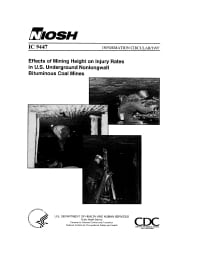Mining Publication: Effects of Mining Height on Injury Rates in U.S. Underground Nonlongwall Bituminous Coal Mines
Original creation date: November 1997
Authors: BA Fotta, LG Mallett
NIOSHTIC2 Number: 00241472
Pittsburgh, PA: U.S. Department of Health and Human Services, Public Health Service, Centers for Disease Control and Prevention, NIOSH, DHHS (NIOSH) Publication No. 98-104, Information Circular 9447, 1997 Nov :1-32
A study was conducted examining the effects of mining height on injury rates in United States underground nonlongwall bituminous coal mines after controlling for number of employees and mining methods. Data were obtained from employment and accident/injury databases of the Mine Safety and Health Administration (MSHA). Nonfatal disabling injury rates were determined for the 5 year period from 1990 to 1994. Details regarding the populations of the mines included in the analysis and the demographics of injured miners were described. A total of 22,607 underground nonfatal injuries which had corresponding seam height information were reported to the MSHA over the study period; 91.6% of these were due to handling materials, machinery, powered haulage, slip or fall of person, fall of mine roof, and/or nonpowered hand tools. The strongest relationship between seam height and injury rates was seen for walking/running and crawling/kneeling activities. Accidents involving load, haul, and dump types of powered haulage equipment demonstrated the most consistent trend in injury rates associated with differences in seam height. Injury rates declined as seam height increased for all mine types for these types of accidents. The lowest rates of injuries involving shuttle cars and the highest rates of injuries involving powered haulage conveyors were observed in low seams across all mine sizes. Fatal and non fatal injury rates for machinery accidents involving roof bolters and nonfatal injuries resulting from falls of roof were lowest in high seam mines, with the exception of the largest mines. Nonfatal disabling injury rates for material handling accidents and injury rates for accidents involving powered haulage locomotives were greater in larger mines. Fatal and nonfatal injury rates for accidents involving continuous mining machines were inversely proportional to mine size. The authors conclude that the effects of mining height on injury rates warrant further investigation.

NIOSHTIC2 Number: 00241472
Pittsburgh, PA: U.S. Department of Health and Human Services, Public Health Service, Centers for Disease Control and Prevention, NIOSH, DHHS (NIOSH) Publication No. 98-104, Information Circular 9447, 1997 Nov :1-32